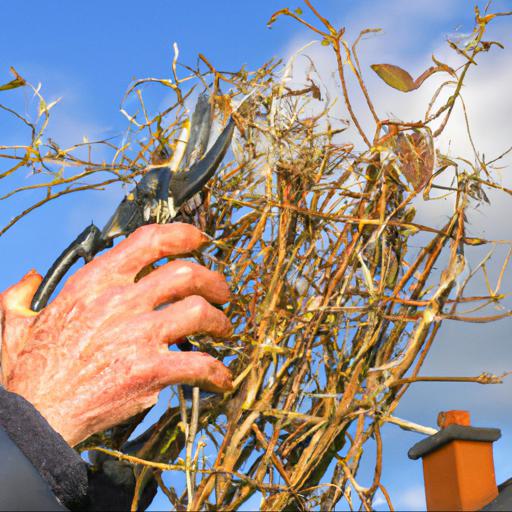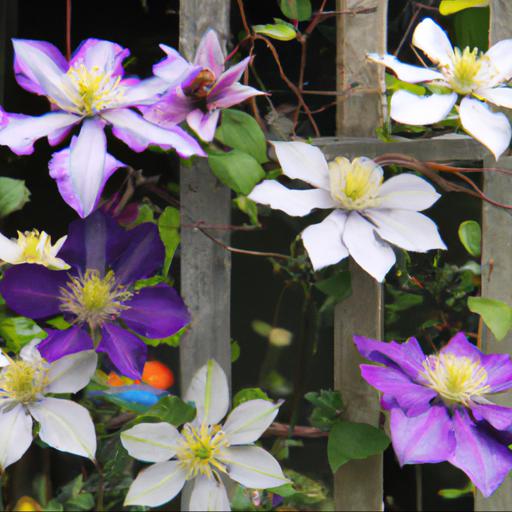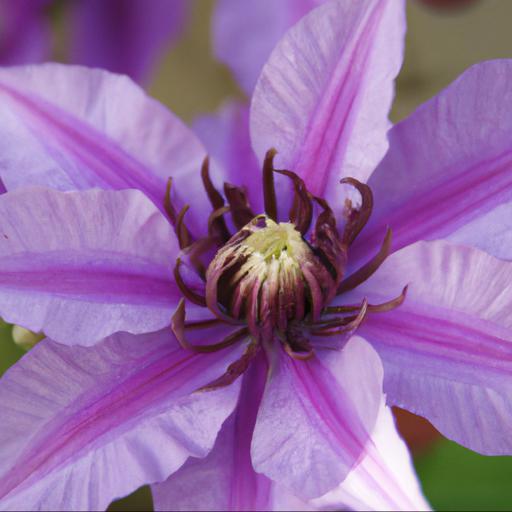Welcome to our blog! Here, we will explore the many uses of clematis for every season. Whether you are looking for a beautiful climbing plant to add to your garden, a unique way to decorate your home, or a creative way to spruce up your outdoor space, clematis is the perfect choice.
We will discuss the different varieties of clematis, how to care for them, and how to use them to create amazing displays in your garden. So come along and explore the beauty of clematis for every season!
Planting clematis for every season: tips and tricks

Us garden experts can confidently assure you that a garden is never truly complete without the addition of a beautiful Clematis. The versatile vine is known for its endless colors and full flowering potential, transforming any outdoor space into an elegant paradise.
But what’s the best way to ensure your clematis blooms throughout each season? Here are a few tips and tricks to guarantee you get the most out of your plantings. First, when planting your clematis, it’s important to consider each variety’s preferences.
For example, spring-flowering varieties should be planted in full sun or partial shade, while late-flowering types are significantly more tolerant of shade. Knowing your plant’s needs is the first step to ensuring great blooms. Additionally, you want to plant your clematis near a wall or fence at least 6 feet tall.
If the trellis you’ve planted your clematis near is wider than 6 feet, it would be wise to tie a couple of the main stems to the wall or fence and let the rest climb the trellis. This will help your clematis produce blooms that not only enhance the trellis but also the wall or fence.
As experts, we advise strongly to prune your clematis each year in late spring. Pruning helps promote new flowering shoots, and good air- circulation around the plant, which can mean a heavier bloom. If you’re ever unsure about which particular pruning group your clematis belongs to, there’s no need to fear—clematis should have a label with their pruning group on it if you purchased it from a reputable nursery.
Make sure you consult this before you prune!All in all, although a tad more attention is needed when planting and caring for a clematis, the reward is worth it.
And when done correctly, you will enjoy vibrant, healthy blooms throughout the seasons, from spring to fall.
Pruning and maintenance of clematis for every season

:When it comes to perennial flowering shrubs, there is hardly a garden shrub more beautiful than the clematis. A flower that blooms the entire season with various colors, the clematis can create an absolutely stunning display in any garden. However, this beauty doesn’t come without some effort.
To keep your clematis looking its best for every season, you need to be sure to prune and maintain your plants properly. In the late winter or early spring, you should make the first of your annual prunings.
Start by pruning away any of the dead or damaged pieces of stems that may have been damaged by the cold months of winter. Then, you should seriously consider pruning back your trellised clematis plants.
This will allow the plants to increase their blooms and create fuller and healthier plants overall. It is important to note that many clematis varieties need to be pruned in different ways. Make sure you research the particular variety you are pruning to make sure you are following the right procedure.
In addition to your pruning, you need to take into account the position of your clematis and the correct planting techniques. Planting in full sun is ideal, but you will still need to provide a bit of shade if you live in a warmer climate. Be sure to fertilize and water your plants on a regular basis as well.
With a bit of careful pruning and maintenance, you can create a stunning floral display every season. Never underestimate the beauty of the humble clematis!
Different varieties of clematis for every season

. When it comes to gardening, one of the most popular and versatile plants around is the clematis. This beloved vine offers blossoms of all kinds of colors, shapes and sizes, making it a great choice for all types of gardeners and garden designs.
What’s more, clematis can thrive in a range of climates, making them ideal for gardeners who live in cooler or warmer regions. Best of all, there are a variety of clematis plants to choose from, perfect for every season!
When spring comes around, the clematis Montana is a great option for those who want to enjoy a profusion of double or semi-double blooms. The Montana variety blooms in shades of white, pink and rosy-red, while its vigorous climbing habit can reach up to 15 feet in length. For those looking to add a burst of color to their garden, the clematis Niobe is an extremely vibrant choice.
This variety’s blooms are a deep, velvety red and offer an incredibly long flowering season, usually from May all the way through to October. In summer, the clematis viticella deserves special mention for its amazing range of colors.
This profuse bloomer offers intensely colored cup-shaped blooms in shades ranging from pink to rosy-purple and even deep violet – perfect for making a bold statement in your garden. Those looking for white flowers with a soft, romantic feel should look no further than the clematis alba. This charming climber produces large single blooms of milky-white and has an extremely long flowering period that can stretch from June to September.
As autumn arrives, the clematis armaniaca is a great choice for gardeners who want to enjoy a gorgeous display of red and yellow flowers. It is a semi-evergreen variety with large blooms that can range from deep wine-red to shades of golden-yellow, a fantastic look to celebrate the autumn season.
For a less traditional option to add a pop of color in fall, the clematis tangutica will not disappoint. Its bright tone of star-shaped yellow blooms make it a great option for brightening up darker days as the summer comes to an end. No matter what season you are planning for, clematis plants are the perfect way to add beauty and variety to your garden. With the range of varieties available for every season, you can keep your garden constantly looking its best!
Troubleshooting common problems with clematis for every season
As a UK garden expert, understanding how to troubleshoot common problems with clematis for every season is the key to having a thriving garden. Clematis is a genus of flowering plants that can be seen in gardens throughout the UK.
It is a resilient plant that can withstand most weather conditions, but it is important to be aware of the common problems that can arise with these plants throughout each season in order to enjoy the flowers and fruits they can provide. Spring is a season of growth and blooming, and although clematis can weather the wetter months beautifully, it can suffer in warm and dry conditions. Fortunately, this is easy to combat by making sure the roots are kept moist – this may include adding a layer of mulch to the base of the plant and ensuring they are watered regularly.
Another thing to look out for is browning leaves – this could be an indication of a lack of adequate drainage, so if you see any wilting or discoloration, consider installing a drainage system or move the plant to a more suitable area. Summer can bring a range of weather conditions and can often be too hot for clematis.
During this season, look out for signs of dehydration, such as wilting, yellowing or browning leaves and stems. To help, keep the plant well-watered and consider using an aerated pot or potting soil so that the soil stays cool and airy around the roots. If the clematis is showing signs of stress, provide adequate shade and avoid direct sunlight.
Autumn and winter are two of the harsher seasons for clematis and can often result in damage to stems and flowers. Although the plant is generally quite hardy, it is prone to fungal issues such as powdery mildew. Keep an eye out for any discolored foliage or white spots as this could be a sign that the plant is not getting adequate air circulation.
To help, it is important to make sure the environment is clean and dry, and to remove any infected or dead leaves. Overall, a lot of the problems that can occur with clematis in any season can be easily manage with the right care and attention.
By following the advice in this blog post, you can ensure your clematis is always blooming and healthy, giving you a beautiful garden to enjoy year round.
Final Touch
Clematis is a beautiful flower that can be enjoyed all year round. With a wide variety of colors, shapes, and sizes, there is a clematis for every season. From the early-flowering varieties in spring to the late-flowering varieties in fall, clematis can add beauty and interest to any garden.
With proper care and maintenance, these hardy vines can provide years of enjoyment. So, why not add a clematis to your garden this season and enjoy the beauty of this versatile flower all year long!
FAQ
What types of clematis are best for each season?
The best types of clematis for each season depend on the climate. In cooler climates, spring-blooming varieties such as ‘Jackmanii’ and ‘Nelly Moser’ are best for spring, while summer-blooming varieties such as ‘Henryi’ and ‘Ville de Lyon’ are best for summer. In warmer climates, winter-blooming varieties such as ‘Apple Blossom’ and ‘Early Sensation’ are best for winter, while fall-blooming varieties such as ‘Duchess of Edinburgh’ and ‘Mrs. Cholmondeley’ are best for fall.
How can I ensure my clematis plants thrive throughout the year?
To ensure your clematis plants thrive throughout the year, provide them with plenty of sunlight, water them regularly, and fertilize them with a balanced fertilizer. Additionally, prune them regularly to promote healthy growth and flowering.
What are the best planting techniques for clematis in different seasons?
The best planting techniques for clematis in different seasons depend on the type of clematis. For spring-flowering clematis, it is best to plant in the fall. For summer-flowering clematis, it is best to plant in the spring. For evergreen clematis, it is best to plant in the spring or fall. For all types of clematis, it is important to ensure that the soil is well-draining and that the roots are kept cool and shaded.
What are the best pruning techniques for clematis in different seasons?
The best pruning techniques for clematis in different seasons depend on the variety of clematis. Generally, spring-flowering varieties should be pruned in late winter, while summer-flowering varieties should be pruned in early spring. Late-flowering varieties should be pruned in early summer.
What are the best fertilizing techniques for clematis in different seasons?
In the spring, the best fertilizing technique for clematis is to use a balanced fertilizer with an equal ratio of nitrogen, phosphorus, and potassium. In the summer, a high-phosphorus fertilizer should be used to encourage flowering. In the fall, a low-nitrogen fertilizer should be used to help the plant prepare for winter dormancy.
What are the best pest control techniques for clematis in different seasons?
In the spring, the best pest control technique for clematis is to remove any dead or diseased stems and leaves, and to prune the plant regularly. In the summer, it is important to monitor the plant for signs of infestation, and to use an insecticidal soap or horticultural oil to treat any pests. In the fall, it is important to clean up any debris around the plant, and to apply a fungicide to help prevent disease.

